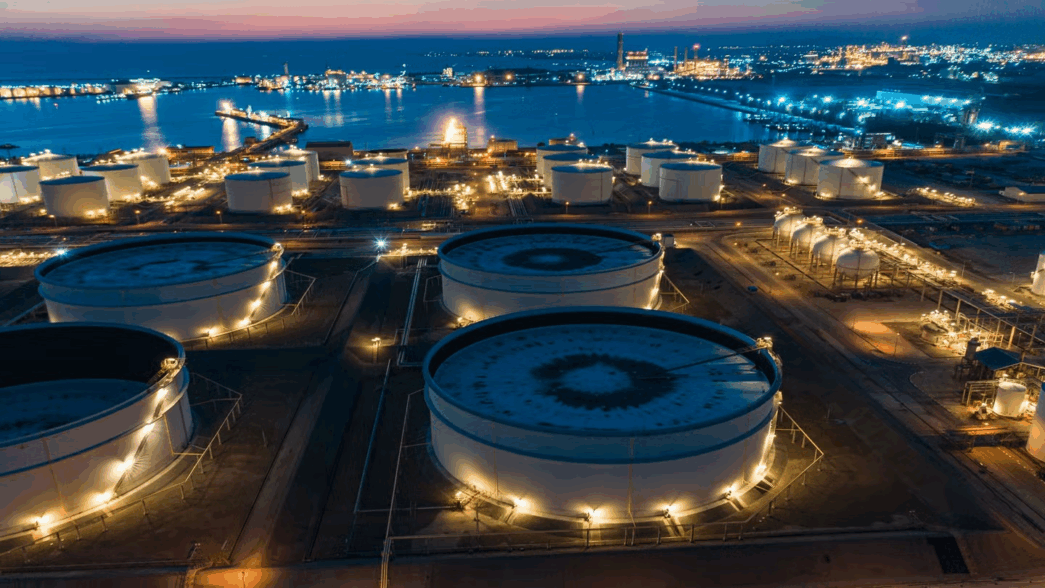For those who never believe or see anything good in Nigeria, a first-of-its-kind crude oil export terminal that will change the narrative in the oil and gas sector is unfolding in the south-south geo-political zone of the country. One of the major hindrances to Nigeria’s economic growth is the lack of infrastructure that will signpost dynamic development for a better tomorrow. Incidentally, the country is blessed with abundant human and natural resources that are unparalleled in any African country. Yet, the infrastructural deficit is taking its toll on the most populous country in Africa. But a remarkable game changer is taking place in a serene environment in Otakikpo, in Andoni LGA of Rivers state.
It is refreshing to note that the first indigenous crude oil terminal has been established in Otakikpo, with gigantic structures that will herald positive development in the petroleum sector. It is incredible to note that Nigeria, generally ranked as the 16th largest oil producer in the world and Africa’s largest oil producer, did not have its own crude oil terminal until the end of March 2025. Prior to the establishment of a $400 million crude oil terminal by Green Energy International Limited (GEIL) in Otakikpo, Rivers State, Nigeria had been relying on five onshore crude oil terminals built by foreigners, with the capacity to pump 300,000 barrels of oil per day into seaborne export transportation units.
These terminals include the Bonny Terminal, built by Shell Petroleum and now operated by Renaissance Africa Energy Limited; the Qua Iboe Terminal, built by Mobil Producing and now operated by Seplat Energy; the Brass Oil River Terminal, built by Nigerian Agip and now operated by Oando; the Forcados Terminal, built by Shell Petroleum and now operated by Renaissance Africa Energy Limited; and the Escravos Terminal, now operated by Chevron. These five terminals are the export points of about 50 per cent of Nigerian crude oil condensate. But they were built by multinationals over 50 years ago to receive crude from fields operated by these companies and to export it to foreign markets on their terms and conditions.
Interestingly, GEIL’s first indigenous crude oil terminal has now changed the foreign dominance of the terminal system, as the country can now beat its chest and compete favourably in the oil and gas sector in line with the “First Nigeria Policy” being promoted by the President Bola Tinubu-led administration.
Advertisement
Speaking on the uniqueness of the crude oil terminal, the Chairman of GEIL, Professor Anthony Adegbulugbe, disclosed that the first indigenous onshore oil terminal built by the company would play a significant role in the oil and gas industry in Nigeria. According to Adegbulugbe, the terminal is a product of two years of investment after 50 years of reliance on facilities put in place by foreigners.
On what prompted him to establish the crude oil terminal, Adegbulugbe said: “The whole idea is a project whose time has come. Because, right now, we have an ageing network of export infrastructure that has been a limiting factor to the production of oil in Nigeria. We have put in place a modular facility of 750,000 barrels’ storage capacity that is expandable to 3,000,000 barrels, and we are working with relevant stakeholders to keep recording successes.”
Regarding those who will benefit from the terminal, Adegbulugbe disclosed that the facility is designed to cater for four sets of investors. His words: “The Otakikpo Terminal, which is the newest, caters for four sets of E&P companies. The first set is those which have small reserves far away from oil export infrastructure and can’t afford to build a pipeline because of the small reserves. This time around, they have a solution through the trucking option — that is, they can truck 1,000–1,500 barrels into our terminal. Getting to the terminal, we have a very good road network. So, if you are around 50 kilometres or thereabouts, you can come to the Otakikpo Terminal.
Advertisement
“Then, another set of companies have fields around creeks where they can’t do any trucking but can do barging. Again, we cater for those in that category. They can barge or even aggregate and come to what we call Kilometre 6, because we already have a pipeline from our field to 6 kilometres offshore, and it is bi-directional, which we are using right now for our export as we can turn it around. You can bring your barge to Kilometre 6, pump your oil onshore, and from onshore it goes directly into our terminal. So that again gives succour to those fields, and there are so many of them.
“The third set of investors are those who have fields 20 kilometres offshore. One of the mitigating factors for them in exporting is that they may not have enough capital to facilitate the required facility. Again, we have a 23-kilometre bi-directional pipeline offshore. They can have a smaller vessel, produce, and come to Kilometre 23, and pump again onshore to export. The fourth set are companies within 40 kilometres from us. Even if they have enough money for the required infrastructure, there is the issue of theft. They produce 100 barrels and get paid sometimes for about 80 per cent, with 20 per cent lost, and that impacts their bottom line. Again, we offer a solution.” He added that the pipelines are designed to be in three phases as part of strategies to ensure safety.
“All the pipelines coming to us are designed to be three-phase, multipurpose solutions. That is, you give us your oil, your water, your gas. With gas in that pipeline, it is relatively safe from vandalisation. So, we offer that solution. You are sure that if you bring your 100 barrels to our terminal, you can get paid for 100 barrels. This is the kind of option we are bringing to the table.”
Inaugurating GEIL’s $400 million crude oil export terminal in Otakikpo, Rivers State, on 8 October 2025, President Tinubu disclosed that the project represented a new chapter in Nigeria’s oil and gas industry, saying that the terminal aligned directly with the core priorities of his administration to ramp up crude oil production by enabling a secure, transparent, and efficient evacuation system.
Advertisement
Tinubu explained that the Otakikpo Terminal will not only serve GEIL’s operations but also provide an efficient evacuation outlet for marginal and stranded fields across the Niger Delta region, unlocking billions of barrels of reserves and creating value for the economy.
Tinubu, who was represented at the event by the Minister of State for Petroleum Resources (Oil), Senator Heineken Lokpobiri, stressed that the project was also a shining example of his government’s expectations of current licensees. He noted that, having provided what he described as “globally competitive fiscals and incentives”, his expectation was that they would put their fields to work to meet set obligations. He said, “Today’s commissioning is more than just the opening of a terminal; it is a testament to Nigeria’s resilience and commitment — a new era of indigenous participation and progress in our oil and gas sector.”
Speaking on financing challenges in the oil and gas sector, the President stated that the era would soon be over, assuring that the $5 billion African Energy Bank (AEB) was about to commence operations and would ease the difficulty of obtaining funding. He said: “Let me also assure Green Energy that the era of perhaps looking elsewhere for finance will soon be over. We have discovered that the biggest challenge we have in Africa is access to finance. And that was why we’ve come up with the African Energy Bank, which is ready to go.” The President further disclosed that another major issue in the oil sector is the evacuation of crude oil, noting that the new 750,000-barrel facility — expandable to 3 million barrels — will help ameliorate such existing problems.
Also speaking at the event, the Chief Executive of the Nigerian Upstream Petroleum Regulatory Commission (NUPRC), Mr Gbenga Komolafe, described the terminal as historic on two levels. He explained that, apart from expanding Nigeria’s crude export infrastructure at a critical time, the terminal demonstrates the capacity of Nigerian operators to deliver world-class projects. Komolafe also expressed the view that the Otakikpo Terminal project aligns with the country’s current 1.8 million barrels per day near-term production projection and the need for efficient evacuation.
Advertisement
By creating an alternative export hub in Rivers State, Komolafe emphasised that the Otakikpo Terminal reduces over-reliance on existing terminals, many of which are already operating near capacity and are exposed to security and pipeline challenges. According to him, indigenous operators in the industry have evolved to the stage of accounting for 30 per cent of national production — a testament to how Nigerians are taking over the oil and gas sector.
Komolafe said: “It is of benefit to indigenous producers. In the past, Nigeria had to rely heavily on infrastructure owned by international oil companies, often at high crude oil handling charges and transportation costs. In this situation, we are all aspiring to reduce the unit cost per barrel. The rise of indigenous terminals such as Otakikpo Terminal will change that dynamic and give local companies direct control over evacuation. This will not only improve margins but also reduce delays and strengthen their overall competitiveness.”
Advertisement
In his remarks at the event, Professor Adegbulugbe said the storage capacity of the terminal is currently 750,000 barrels, expandable to 3 million barrels. The Green Energy boss further disclosed that the facility has a pumping capacity of 360,000 barrels per day, pointing out that since June 2025, the company has completed four export operations, totalling 1 million barrels of crude oil. Adegbulugbe also disclosed that beyond the numbers, the terminal is a catalyst for national renewal, as it opens the door for more than 40 stranded fields in the region, with over 3 million barrels of reserves, long held back by a lack of export infrastructure. He added that the fields alone could contribute more than 200,000 barrels per day to the country’s production.
His words: “This terminal is not just another infrastructure project. It is the realisation of a vision that says Nigeria can lead; that Nigerian companies can deliver; that our energy future is ours to define. I am proud to state that this facility was conceived, designed, and delivered 100 per cent by Nigerian talent. From engineering to construction, it reflects the depth of expertise and capacity that resides in our nation. This should give us all confidence — Nigerian innovation can drive Nigerian success; indigenous operators can execute world-class projects with excellence, within budget, and ahead of schedule.”
Advertisement
This writer and other invited guests for the inauguration observed during a facility tour that the first indigenous crude oil terminal occupies a sprawling area and contains gigantic structures with state-of-the-art equipment. The terminal stands out as the first privately developed crude oil terminal by an African operator. Designed to support up to 250,000 barrels per day of crude injection, the terminal currently processes output from the Otakikpo field, which produces about 10,000 barrels per day. It also offers strategic opportunities for third-party producers, particularly the more than 40 nearby stranded fields estimated to contain over 3 billion barrels of oil equivalent (BOE).
In addition to unlocking stranded reserves, the terminal’s proximity to the Ogoni and Opobo fields aligns with President Tinubu’s administration’s renewed efforts to revitalise these long-dormant assets, which have remained underdeveloped for more than 30 years. GEIL’s infrastructure provides a cost-effective evacuation route for these fields, enhancing Nigeria’s production capacity and export potential.
Advertisement
The development explains why GEIL’s establishment of the Otakikpo Terminal in Rivers State will be a game changer and will continue to remain a reference point in the history of oil and gas exploration and production in Nigeria.
The newly constructed Otakikpo Terminal boasts an initial storage capacity of 750,000 barrels, with potential expansion to 3 million barrels. It also features a 360,000 barrels per day pumping capacity for loading export tankers, making it one of the most significant infrastructure projects in Nigeria’s energy landscape, and making history as the first privately developed crude oil terminal by an African operator. With an initial investment exceeding $400 million and a full-phase development projection of $1.3 billion, GEIL’s commitment to expanding Nigeria’s oil export infrastructure is evident.
Now that the terminal has been inaugurated by the president and is fully functional, it is a feat that should be celebrated by Nigerians as well as by the government in general. It shows that Nigeria can get it right in other sectors of the economy in due course if the right persons are saddled with strategic responsibilities.
Remarkably, the Otakikpo crude oil terminal marks a historic milestone as Nigeria’s first indigenous onshore crude export facility in more than five decades.
Amokeodo, a senior journalist and media consultant, contributes this piece from Abuja.
Views expressed by contributors are strictly personal and not of TheCable.









